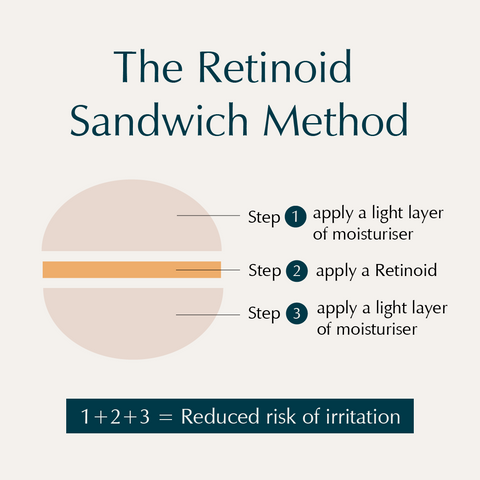5 min read
Retinoid Series
We know that incorporating Retinoids into your routine for the first time can be challenging or even scary for some. When not properly formulated or used incorrectly, it can induce skin irritations and hinder the great benefits of retinoids. This series is really about eliminating some of these fears so you can be confident using this ingredient in your routine with ease.
Now that you have learnt all about Retinoids in part one of our Retinoid Series, you might be thinking - how do I go about using it? This second part of our series highlights some good practices when it comes to using Retinoids.
Retinoids are clinically proven to treat a myriad of skin concerns from breakouts to fading hyperpigmentation, boosting collagen, improving the appearance of fine lines, wrinkles, skin elasticity and skin texture. Yet this all-star ingredient also comes with its own set of drawbacks. It can be renowned for causing irritation, redness, flakiness, dryness and a host of other skin flare-ups if used incorrectly or when your skin is not acclimated to them.
Today we are going to cover some guidelines on how you can better acclimate your skin for retinoid use according to your level of experience. First up, here are some guidelines of use:
Key general guidelines of use
- Always patch test (any new product for at least 48 hours).
- Start slowly and gradually increase the frequency of use.
- Use a retinoid sandwich method when starting to use retinoids to reduce the risk of redness/irritation (this is where you layer your moisturiser, then your retinoid and finally another light layer of moisturiser on top - remember to layer instead of mixing with your moisturizer).

The Retinoid Sandwich Method
The Retinoid Sandwich Method is a gentle approach to integrating retinoids into your skincare routine to minimize irritation.
The method involves three key steps:
- Applying a light layer of moisturizer to your skin to prepare it.
- Applying a retinoid product over the moisturizer.
- Finishing with another light layer of moisturizer on top of the retinoid.
This layering technique helps to reduce the risk of redness and irritation often associated with retinoid use, especially for new users or those with sensitive skin. You start with once a week application, gradually increasing as your skin acclimates, while being cautious not to mix retinoids with other strong actives like acids at the beginning. It's also crucial to ensure skin is dry before application and to use SPF daily as retinoids can increase skin sensitivity to the sun.
New Users & Sensitive Skins
- Use at night only.
- Follow the retinoid sandwich method (see above).
- Limit use to once a week (to begin with).
- Gradually increase frequency to twice a week or as tolerated by your skin.
- Try to remove other exfoliants in your routine until your skin acclimates to the retinoid. If you want to continue to use leave-on acid exfoliants in your weekly routine, we suggest alternating use with your retinoid. In other words, use them on nights you are not using your retinoid.
- If you are using other actives like Vitamin C in the evening, switch use of these to during the day until your skin is acclimated to the retinoid.
- Do not increase frequency of use after 2-3 applications as delayed sensitization can occur with retinoids.
Experienced Retinoid Users
- Even if you are an experienced user every product has been formulated uniquely so do not make the mistake of comparing % to determine formulation potency as you may find that your skin tolerates different products differently.
- Start using it twice a week, 3 days apart.
- Build up frequency to every other day or as tolerated by your skin.
- Continue to layer moisturising ingredients over your retinoid to prevent issues of sensitization.
- If you are used to layering acid exfoliants and retinoids we recommend that you start this practice again only when your skin is acclimated to your new retinoid and continue to pay attention to your skin tolerance, scaling back your use if needed.


Avoid these mistakes when applying your retinoid:
Applying to wet/moist skin
Wet skin can enhance the penetration or increase the concentration of product entering your skin and this can further irritate your skin so make sure that your skin is dry to the touch before layering your retinoid.
Overapplying more than a pea-sized amount
With retinoids, a little goes a long way, use only a pea-sized amount to get its amazing benefits.
Mixing with other acids and retinoids when applying (especially if you have sensitive skin or are a new retinoid user)
Layering retinoids with acids can irritate your skin. While resilient skins or very experienced retinoid users may be able to layer acids and retinoids with little to no irritation, sensitive skin/new retinoid users should stay away from this combination.
Forgetting to apply / Not using adequate amounts of SPF
It is important and non-negotiable that you apply SPF daily and reapply every 2 hours if you are outdoors as retinoids increase the skin’s sensitivity to the skin.
Applying to sensitive eye & lip areas
If you have sensitive eye areas you may want to avoid these areas altogether when applying your retinoid or apply a moisturiser or eye cream around this area first to avoid the risk of irritation. If you have sensitive lips, it is recommended you apply a lip balm before applying your retinoid to make sure that there is no transfer of the retinoid into the thin lip area causing irritation and flakiness of the lips.
By following these rules and guidelines (and of course listening to your own skin needs) you should be all set to begin your Retinoids use! Stay tuned for Part 3, where we debunk some myths surrounding this potent ingredient.




